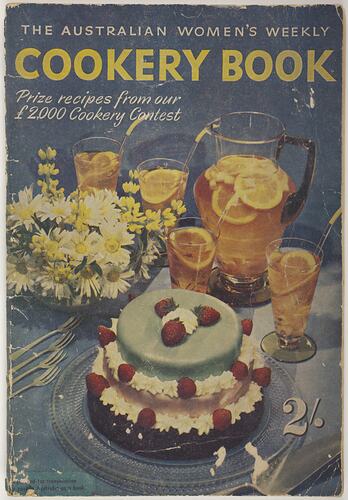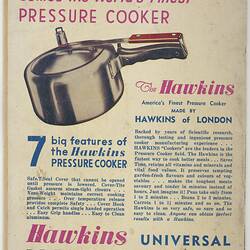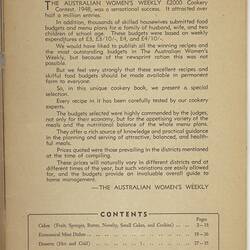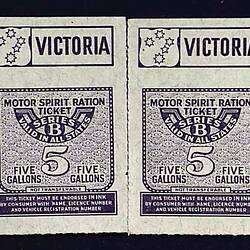Summary
Alternative Name(s): Cookery Book, Cook Book
Recipe booklet published by the Australian Women's Weekly, and based on prize recipes and menu plans from their 1948 £2000 Cookery Contest.
The booklet's contents include recipes for cakes, meat dishes, desserts, pastries, breads, and advice on food budgets and menu plans. It also features advertisements for products such as Maxam's cheese, tinned luncheon beef and pastry, and Aerophos flour.
The Cookery Contest that this recipe booklet was based on attracted thousands of entries. Entrants had to provide menu plans for a family of four composed of a husband, wife and two children, with weekly budgets of £3, £3/10 upwards, £4 and £4/10 upwards. Due to newsprint rationing still in force after World War II, it was not possible to publish all of the winning entries in the Australian Women's Weekly magazine at the time of the 1948 contest, so this booklet was probably specially printed after rationing was relaxed. The winning recipes and menu plans were selected for their economy, taste and nutritional balance. Food rationing was still in force when the Cookery contest was held, hence the emphasis on budget and economy was important. Food rationing did not end completely until 1950.
The '£50 champion cake' recipe was 'snowflake cake with egg-nog fillling'. Some of the other cake recipes include 'coffee walnut kisses', 'fairy faces' and 'cherry patty cakes'. The winning meat dish was 'the housewife's companion (shin of beef three ways). Other meat dishes include 'economy flapjacks', 'creamed neck chops with celery' and 'lamb chops Mexicana'. The winning desserts were 'Montreux creme de luxe' and 'spiced pear royal'. Other desserts include 'steamed golden pudding', 'oatmeal prune pudding' and 'quince meringue princesse'. The winning sweet pastry was 'date and ginger cream pie' and the winning savoury pastry was 'creamed scallop pie'. Other pastries include 'coconut nougat tart', 'marmalade banana tart', 'chicken and oyster pie' and 'curried egg pie'.
Physical Description
64 page booklet with black text on white pages, a few black & white photographs and illustrations within the booklet, and a full colour front and back cover. Front cover features a colour photograph of table setting with jug of punch, four glasses and a three tiered cake. Back cover features colour advertisement for Hawkins pressure cookers.
Significance
Shortages of food, clothing and other products were part of life on the homefront during World War II. The first controls over the production and distribution of products were introduced in 1940, partly due to disruption of shipping. In 1942, after Japan entered the War, comprehensive rationing was introduced to manage shortages and control civilian consumption. The first product to be rationed was clothing, gazetted on 12 June 1942. Each adult was allowed 112 clothing coupons per year. Tea rationing was introduced the following month, followed by sugar, butter and then meat. After the War, rationing was gradually phased out. Clothing rationing was abolished on 24 June 1948. The last rationed product was tea, which ended in July 1950.
More Information
-
Collecting Areas
-
Acquisition Information
Donation from Unknown
-
Publisher
The Australian Women's Weekly, 168-174 Castlereagh Street, Sydney, Greater Sydney, New South Wales, Australia, circa 1948
-
Printer & Publisher
Consolidated Press Limited, 168-174 Castlereagh Street, Sydney, Greater Sydney, New South Wales, Australia, circa 1948
-
Inscriptions
Printed, ink, front top: ' THE AUSTRALIAN WOMEN'S WEEKLY / COOKERY BOOK / Prize recipes from our / £2,000 Cookery Contest ' Printed, ink , bottom left: ' Registered for transmission / by post in Australia as a book ' Printed, ink, bottom right: ' 2 / . ' Printed, ink, back: extensive advertisment for pressure cooker which includes ' To the Housewives of Australia / comes the World's Finest / PRESSURE COOKER / ... Hawkins UNIVERSAL / PRESSURE COOKER/ ... Sole Australian Agent: / MOFFAT VIRTUE LTD., EPSOM ROAD, ROSEBERY, N.S.W.' Handwritten, pencil, back, top left: 'Jones'
-
Classification
-
Category
-
Discipline
-
Type of item
-
Overall Dimensions - Closed
185 mm (Width), 5 mm (Depth), 272 mm (Height)
-
Keywords
Cooking, Domestic Economy, Domestic Life, Food, Food & Drink Preparation, Housewives, Magazines, Rationing, Recipes, World War II, 1939-1945




